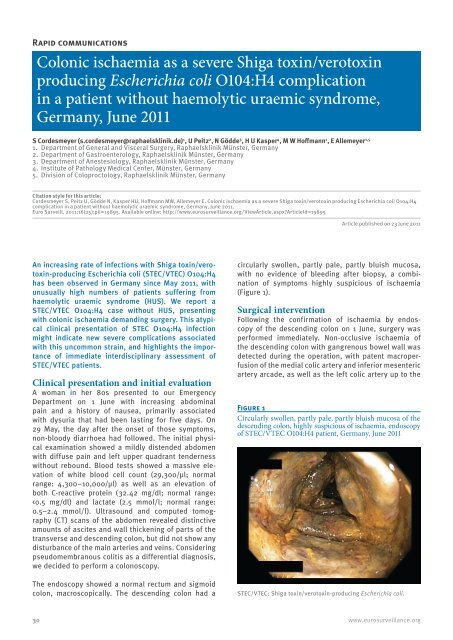Escherichia coli - Eurosurveillance
Escherichia coli - Eurosurveillance
Escherichia coli - Eurosurveillance
You also want an ePaper? Increase the reach of your titles
YUMPU automatically turns print PDFs into web optimized ePapers that Google loves.
Rapid communications<br />
Colonic ischaemia as a severe Shiga toxin/verotoxin<br />
producing <strong>Escherichia</strong> <strong>coli</strong> O104:H4 complication<br />
in a patient without haemolytic uraemic syndrome,<br />
Germany, June 2011<br />
S Cordesmeyer (s.cordesmeyer@raphaelsklinik.de) 1 , U Peitz 2 , N Gödde 3 , H U Kasper 4 , M W Hoffmann 1 , E Allemeyer 1,5<br />
1. Department of General and Visceral Surgery, Raphaelsklinik Münster, Germany<br />
2. Department of Gastroenterology, Raphaelsklinik Münster, Germany<br />
3. Department of Anestesiology, Raphaelsklinik Münster, Germany<br />
4. Institute of Pathology Medical Center, Münster, Germany<br />
5. Division of Coloproctology, Raphaelsklinik Münster, Germany<br />
Citation style for this article:<br />
Cordesmeyer S, Peitz U, Gödde N, Kasper HU, Hoffmann MW, Allemeyer E. Colonic ischaemia as a severe Shiga toxin/verotoxin producing <strong>Escherichia</strong> <strong>coli</strong> O104:H4<br />
complication in a patient without haemolytic uraemic syndrome, Germany, June 2011.<br />
Euro Surveill. 2011;16(25):pii=19895. Available online: http://www.eurosurveillance.org/ViewArticle.aspx?ArticleId=19895<br />
An increasing rate of infections with Shiga toxin/verotoxin-producing<br />
<strong>Escherichia</strong> <strong>coli</strong> (STEC/VTEC) O104:H4<br />
has been observed in Germany since May 2011, with<br />
unusually high numbers of patients suffering from<br />
haemolytic uraemic syndrome (HUS). We report a<br />
STEC/VTEC O104:H4 case without HUS, presenting<br />
with colonic ischaemia demanding surgery. This atypical<br />
clinical presentation of STEC O104:H4 infection<br />
might indicate new severe complications associated<br />
with this uncommon strain, and highlights the importance<br />
of immediate interdisciplinary assessment of<br />
STEC/VTEC patients.<br />
Clinical presentation and initial evaluation<br />
A woman in her 80s presented to our Emergency<br />
Department on 1 June with increasing abdominal<br />
pain and a history of nausea, primarily associated<br />
with dysuria that had been lasting for five days. On<br />
29 May, the day after the onset of those symptoms,<br />
non-bloody diarrhoea had followed. The initial physical<br />
examination showed a mildly distended abdomen<br />
with diffuse pain and left upper quadrant tenderness<br />
without rebound. Blood tests showed a massive elevation<br />
of white blood cell count (29,300/µl; normal<br />
range: 4,300–10,000/µl) as well as an elevation of<br />
both C-reactive protein (32.42 mg/dl; normal range:<br />

















